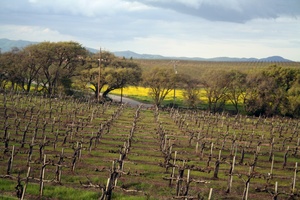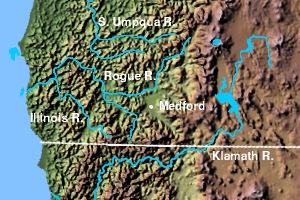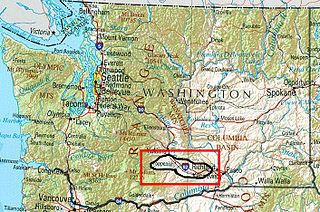
The Livermore Valley AVA is an American Viticultural Area in Alameda County, California, surrounding the city of Livermore in the Tri-Valley region. Both the AVA and the city are named after Robert Livermore, a landowner whose holdings encompassed the valley. The groundwater basin underlying the valley is the Livermore Basin, the largest sub-unit of which is the Mocho Subbasin. The Livermore Basin is one of five aquifers in the San Francisco Bay Area that supply most of the metropolitan Bay Area population. The entire Livermore Basin aquifer faces a concern over elevated total dissolved solids by the year 2020 due to an expanding human population leading to higher rates of return water flows to the aquifer containing certain salts.

The Alexander Valley is a Californian American Viticultural Area (AVA) just north of Healdsburg in Sonoma County. It is home to many wineries and vineyards, as well as the city of Cloverdale. It is the largest and most fully planted wine region in Sonoma. Highway 101 runs through the valley, and the Russian River flows down the valley, surrounded by vineyards on both sides. From the higher elevations of the valley rim, there is a view as far south as Taylor Mountain and Sonoma Mountain. The region was named for Cyrus Alexander, owner of a part of the Rancho Sotoyome Mexican land grant, in 1847. Granted AVA status in 1984, the boundaries of the appellation are defined in the Code of Federal Regulations, Title 27, Section 9.53.

Illinois wine refers to any wine that is made from grapes grown in the U.S. state of Illinois. In 2006, Shawnee Hills, in southern Illinois, was named the state's first American Viticultural Area. As of 2008, there were 79 wineries in Illinois, utilizing approximately 1,100 acres (4.5 km2) of vines.

Washington wine is a wine produced from grape varieties grown in the U.S. state of Washington. Washington ranks second in the United States in the production of wine. By 2017, the state had over 55,000 acres (220 km2) of vineyards, a harvest of 229,000 short tons (208,000 t) of grapes, and exports going to over 40 countries around the world from the 940+ wineries located in the state. While there are some viticultural activities in the cooler, wetter western half of the state, the majority (99.9%) of wine grape production takes place in the shrub-steppe eastern half. The rain shadow of the Cascade Range leaves the Columbia River Basin with around 8 inches (200 mm) of annual rain fall, making irrigation and water rights of paramount interest to the Washington wine industry. Viticulture in the state is also influenced by long sunlight hours and consistent temperatures.
The state of Oregon in the United States has established an international reputation for its production of wine, ranking fourth in the country behind California, Washington, and New York. Oregon has several different growing regions within the state's borders that are well-suited to the cultivation of grapes; additional regions straddle the border between Oregon and the states of Washington and Idaho. Wine making dates back to pioneer times in the 1840s, with commercial production beginning in the 1960s.

Willamette Valley is an American Viticultural Area (AVA) which lies in the Willamette Valley of Oregon. The AVA is the wine growing region which encompasses the drainage basin of the Willamette River. It stretches from the Columbia River in the north to just south of Eugene in the south, where the Willamette Valley ends; and from the Oregon Coast Range in the west to the Cascade Mountains in the east. At 5,360 square miles, it is the largest AVA in the state, and contains most of the state's wineries; approximately 908 as of 2021.

The Rogue Valley AVA is an American Viticultural Area located in southern Oregon. The federal government approved this appellation in 1991. It is entirely contained within the larger Southern Oregon AVA and includes the drainage basin of the Rogue River and several tributaries, including the Illinois River, the Applegate River, and Bear Creek. Most wineries in the region are found in the valleys formed by one of these three tributaries, rather than along the Rogue River itself. The region is 70 miles (113 km) wide by 60 miles (97 km) long ; there are fewer than 20 wineries with only 1,100 acres (450 ha) planted. Each river valley has a unique terroir, and grows different varieties of grapes. Overall, however, this region is the warmest and driest of Oregon's wine-growing regions.

Yakima Valley is the first American Viticultural Area (AVA) established within Washington state, gaining the recognition on May 4, 1983. Within the vast Columbia Valley AVA, Yakima Valley appellation cultivates more than 53,000 acres (21,448 ha) giving the region the largest concentration of wineries and vineyards in the state. The most widely planted varietals in the area are Chardonnay, Riesling, Merlot, Cabernet Sauvignon, Pinot gris, and Syrah. Nearly 40% of Washington's annual wine production is made from Yakima Valley grapes. In addition to grapes, the Yakima Valley is also home to several fruit orchards growing apples, cherries, nectarines, peaches, pears and plums. Around the town of Zillah, there is the Zillah Fruit Loop driving tour through the area's orchards and vineyards. The area is also home to nearly 80% of the US hop production.

New York wine refers to wine made from grapes grown in the U.S. state of New York. New York ranks third in grape production by volume after California and Washington. 83% of New York's grape area is Vitis labrusca varieties. The rest is split almost equally between Vitis vinifera and French hybrids.

The Mendocino County wine is an appellation that designates wine made from grapes grown mostly in Mendocino County, California. The region is part of the larger North Coast AVA and one of California's largest and most climatically diverse wine growing regions. Mendocino County is one of the northernmost commercial wine grape regions in the state with two distinct climate zones separated by the Mendocino Range. Ten American Viticultural Areas have been designated within Mendocino County. Mendocino is one of the leading wine growing regions for organically produced wine grapes. Nearly 25% of the acreage in Mendocino County is grown organically. In 2004, the residents of the county voted to become the first GMO-free county in the United States in an initiative that was supported by many of the county's largest wineries. The county's widespread focus on organic viticulture has inspired journalists to describe it as "California's organic wine Mecca".

Sonoma County wine is wine made in Sonoma County, California, in the United States.

The Russian River Valley AVA is an American Viticultural Area (AVA) in Sonoma County, California. Centered on the Russian River, the Russian River Valley AVA accounts for about one-sixth of the total planted vineyard acreage in Sonoma County. The appellation was granted AVA status in 1983 and enlarged in 2005. The area generally lies between Sebastopol and Santa Rosa in the south, and Forestville and Healdsburg in the north. The Russian River Valley has a characteristically cool climate, heavily affected by fog generated by the valley's proximity to the Pacific Ocean. The area is known for its success with cool climate varietals, notably Pinot noir and Chardonnay.

El Dorado is an American Viticultural Area (AVA) located in El Dorado County, California, east of the state’s capital, Sacramento and centered around the county seat of Placerville. It was established on November 14, 1983 by the Bureau of Alcohol, Tobacco, Firearms and Explosives (ATF), Treasury after approving the submitted petition from the El Dorado Wine Grape Growers Association of Camino, California applying to establish a viticultural area named "El Dorado.” The area includes parts of El Dorado County on the north border by the Middle Fork American River and on the south by the South Fork of the Cosumnes River. El Dorado viticultural area lies within the vast 4,062 square miles Sierra Foothills viticultural area, one of the largest appellations in California, which extends about 170 miles (274 km) through portions of Yuba, Nevada, Placer, El Dorado, Amador, Calaveras, Tuolumne and Mariposa Counties. The El Dorado viticultural area encompasses 1,093,120 acres (1,708 sq mi) which entirely includes Fair Play and a small portion of northeastern California Shenandoah Valley AVAs.

The Finger Lakes AVA is an American Viticultural Area located in Upstate New York, south of Lake Ontario. It was established in 1982 and encompasses the eleven Finger Lakes, but the area around Canandaigua, Keuka, Seneca, and Cayuga Lakes contain the vast majority of vineyard plantings in the AVA. Cayuga and Seneca Lakes each have their own American Viticultural Areas completely contained within the Finger Lakes AVA. The Finger Lakes AVA includes 11,000 acres (4,452 ha) of vineyards and is the largest wine-producing region in New York State.

The Seneca Lake AVA is an American Viticultural Area around Seneca Lake in Upstate New York. The wine appellation is entirely contained within the larger Finger Lakes AVA, and includes portions of Ontario, Schuyler, Seneca, and Yates counties. Seneca Lake is a glacial lake about 35 miles (56 km) long and up to 600 feet (180 m) deep. The lake does not freeze in winter, and acts as a giant heat storage unit for the vineyards surrounding the lake, extending the growing season. The most commercially important grape variety in the region is Riesling, although a wide variety of Vitis vinifera and French hybrid grapes are grown.

The Long Island AVA is an American Viticultural Area encompassing Nassau and Suffolk counties of New York, including the smaller offshore islands in those counties. The AVA was established in 2001, over 15 years after two smaller AVAs were created at the eastern end of Long Island. The Long Island AVA designation was promoted as a benefit for some wineries located just outside the two smaller AVAs and for wineries that wanted to create wines that use blends from vineyards in different parts of the island. It was also developed and promoted as a consumer protection of the Long Island name, as AVAs require that at least 85% of the fruit used in the designated wine is grown within the borders of the region. The "Long Island" AVA was authored by veteran Long Island winemaker Richard Olsen-Harbich who also authored "The Hamptons, Long Island" and "North Fork of Long Island" AVAs in the mid-1980s.
The North Fork of Long Island AVA is an American Viticultural Area located in eastern Suffolk County, New York. Authored by winemaker Richard Olsen-Harbich in 1985, it includes the entire North Fork of Long Island and the townships of Riverhead, Shelter Island, and Southold. The North Fork of Long Island is home to over 40 wineries and 3,000 acres (1,200 ha) of planted vineyards. The local climate is heavily influenced by the presence of Long Island Sound, Peconic Bay, and the Atlantic Ocean. The maritime influences of these bodies of water help to moderate temperature fluctuations and extend the growing season up to a month longer than other regions in New York. The most planted grape varieties in the region are Merlot, Chardonnay, and Cabernet Franc. The hardiness zones are 7a and 7b.
Snipes Mountain is an American Viticultural Area (AVA) located in the Yakima Valley of Washington state. It was established by the Alcohol and Tobacco Tax and Trade Bureau {TTB), Treasury on January 21, 2009 as the state's 10th AVA. It is the second smallest AVA in the state, after the Red Mountain AVA, and has one of the state's longest viticultural histories. The 4,145 acres (6 sq mi) appellation is a sub-AVA of the Yakima Valley AVA and the Columbia Valley AVA. It is located above and between the towns of Sunnyside and Granger around Outlook, Washington, in the southeast corner of the Yakima Valley.

The Upper Mississippi River Valley AVA is an American Viticultural Area covering 29,914 square miles located along the Upper Mississippi River and its tributaries in northwest Illinois, northeast Iowa, southeast Minnesota and southwest Wisconsin. Certified by the United States Department of the Treasury's Alcohol and Tobacco Tax and Trade Bureau on July 22, 2009, it is the largest AVA in the United States. The AVA encompasses an area 50 times larger than the Bordeaux wine regions of France.

The Upper Hudson AVA is an American Viticultural Area located to the north and west of Albany, New York. It is approximately 1650 square miles with nearly 65 acres of vines planted and 19 vineyards. It includes parts or all of seven counties in upstate New York, specifically Albany, Montgomery, Rensselaer, Saratoga, Schenectady, Schoharie and Washington.
















